Module 10 A holiday journey 单元教案 2023-2024学年外研版英语七年级下册
文档属性
| 名称 | Module 10 A holiday journey 单元教案 2023-2024学年外研版英语七年级下册 |
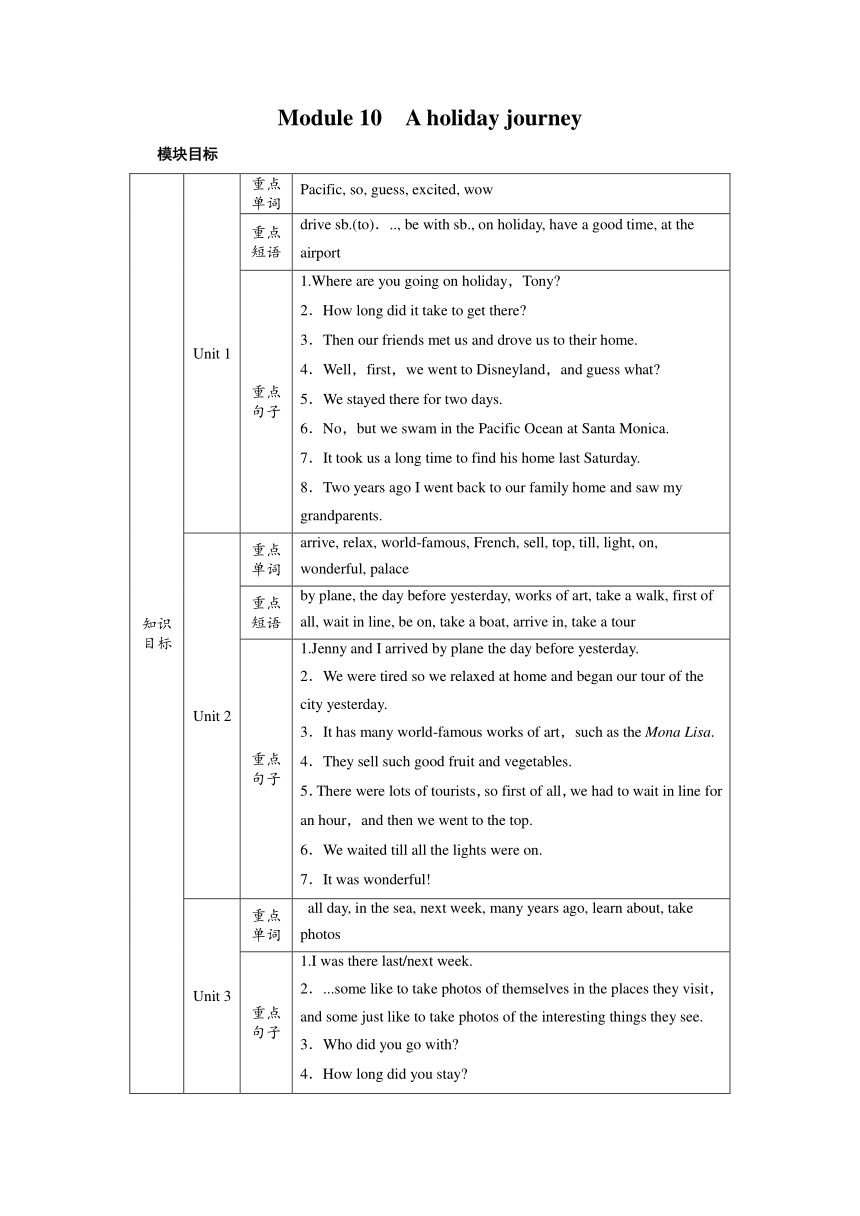
|
|
| 格式 | doc | ||
| 文件大小 | 3.4MB | ||
| 资源类型 | 教案 | ||
| 版本资源 | 外研版 | ||
| 科目 | 英语 | ||
| 更新时间 | 2024-03-02 22:15:36 | ||
图片预览

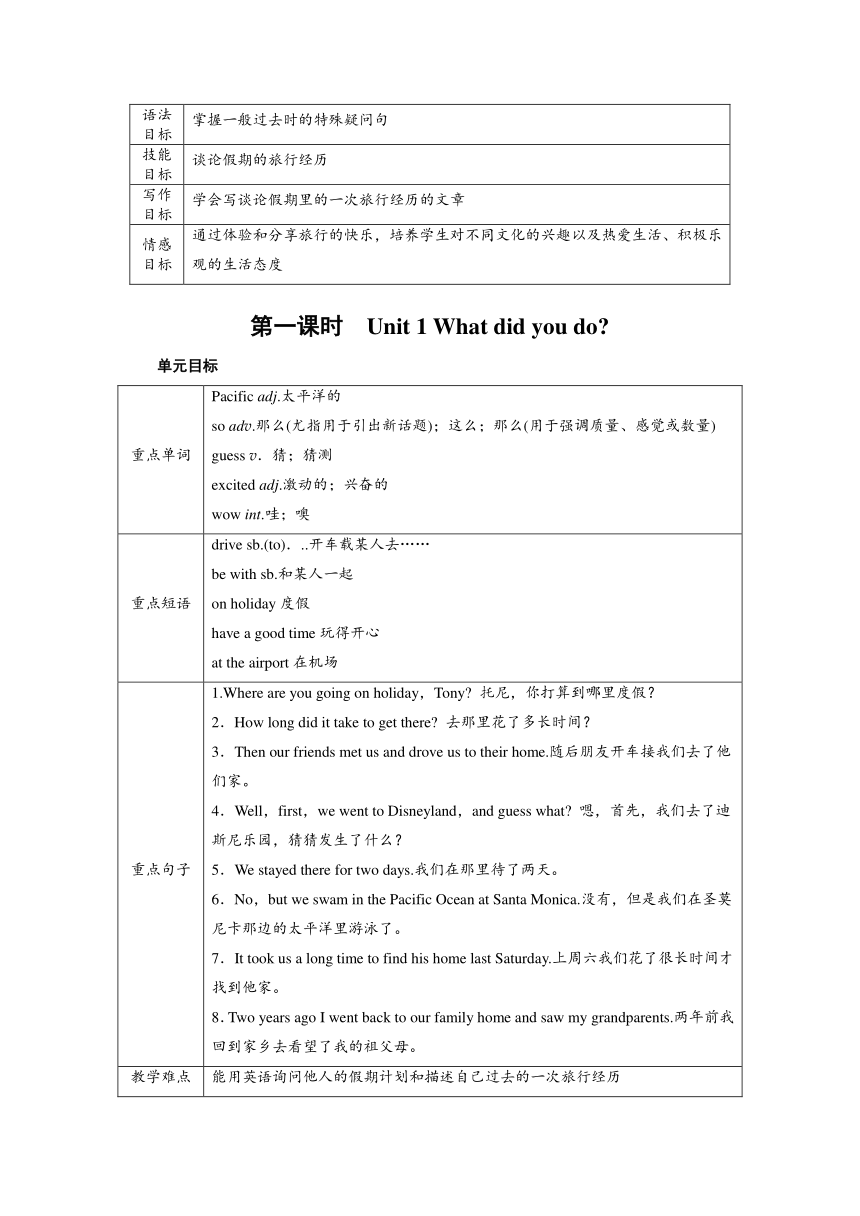
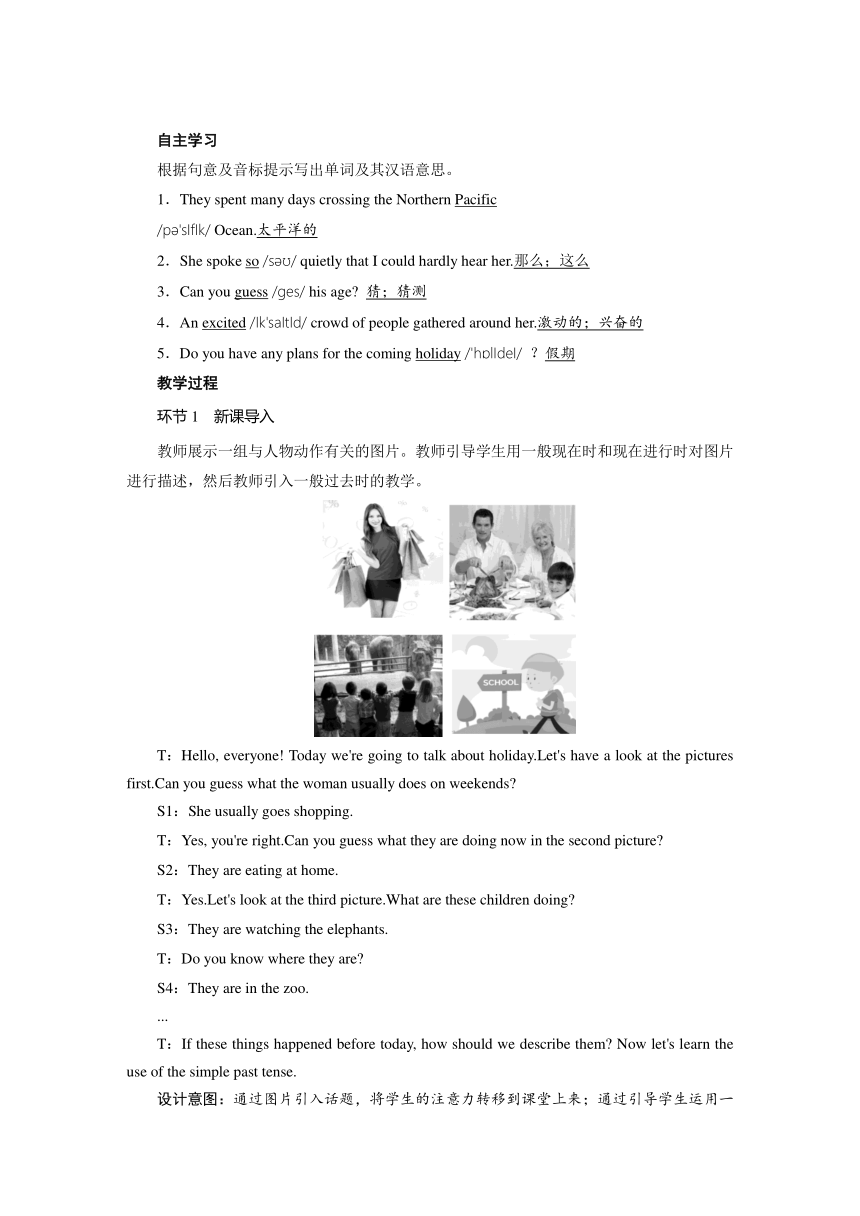
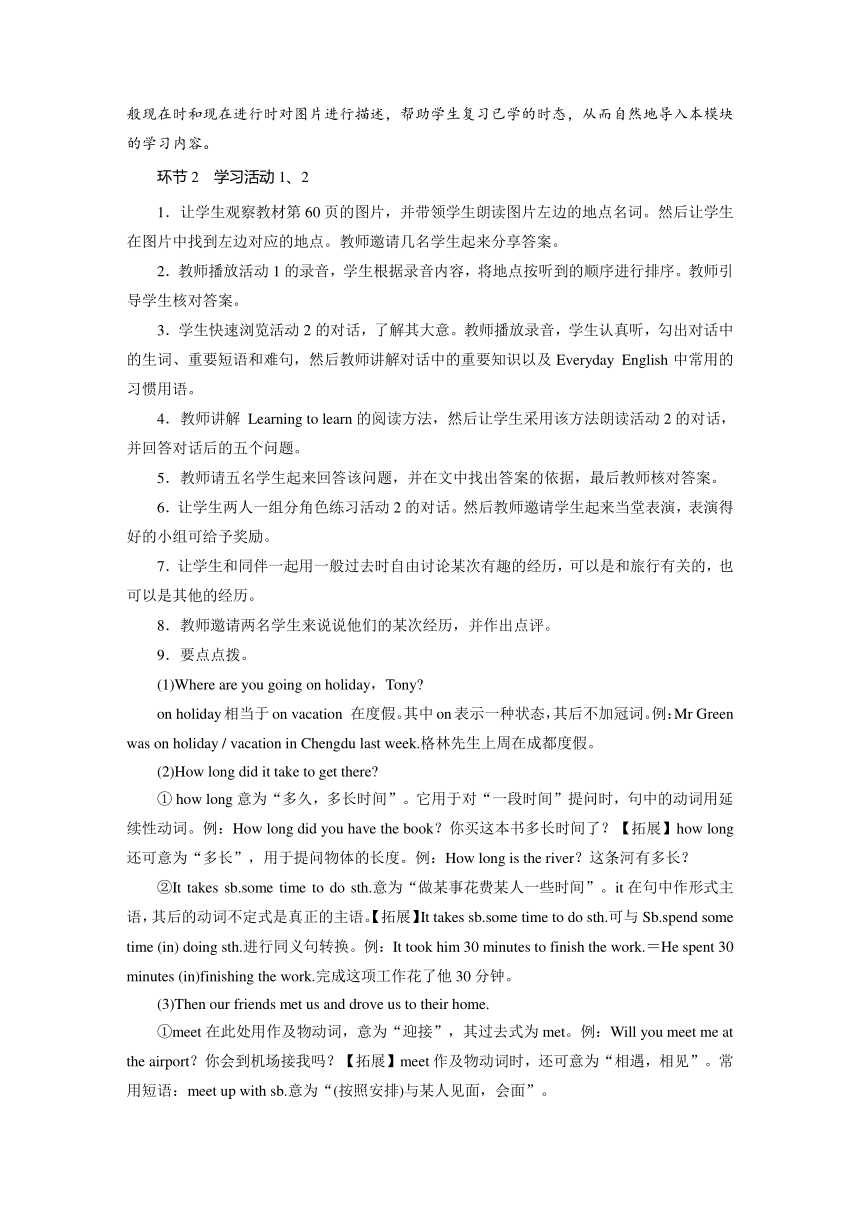
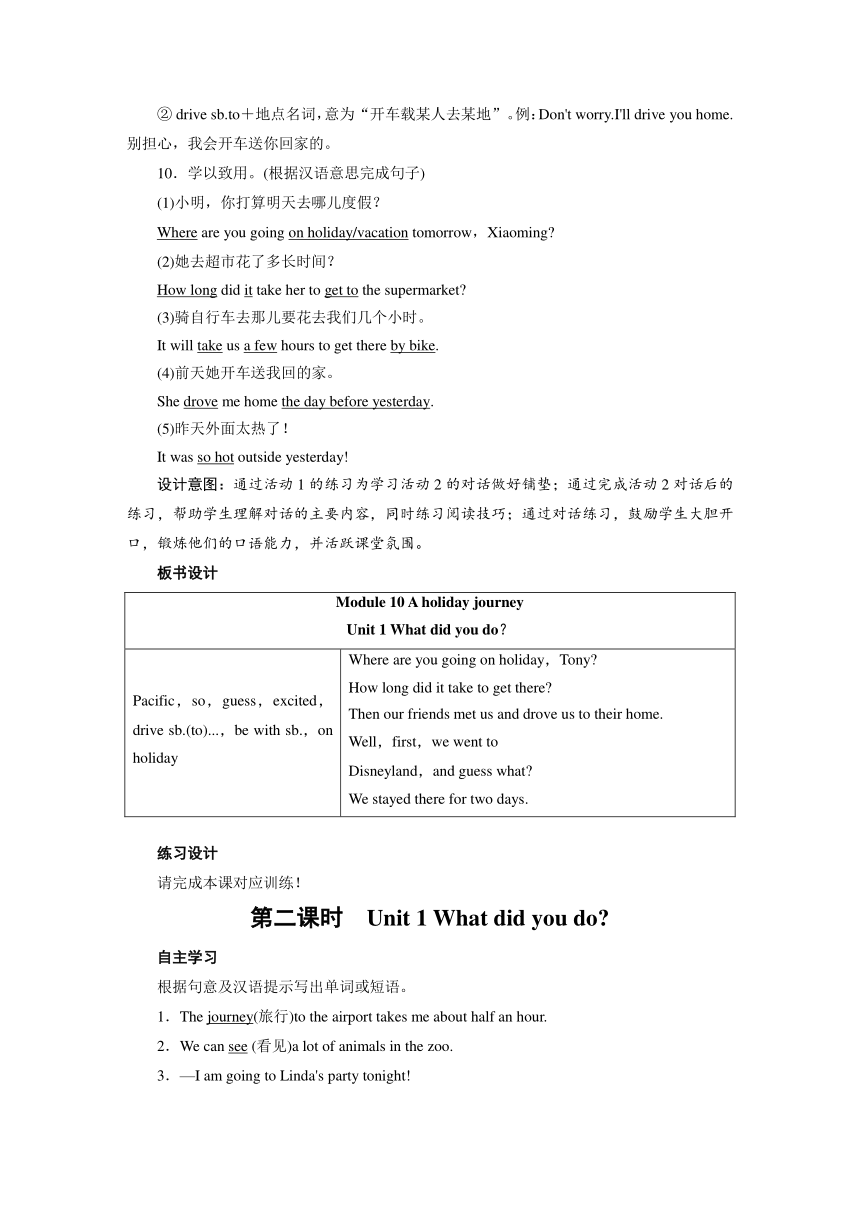
文档简介
Module 10 A holiday journey
模块目标
知识目标 Unit 1 重点单词 Pacific, so, guess, excited, wow
重点短语 drive sb.(to)..., be with sb., on holiday, have a good time, at the airport
重点句子 1.Where are you going on holiday,Tony 2.How long did it take to get there 3.Then our friends met us and drove us to their home.4.Well,first,we went to Disneyland,and guess what 5.We stayed there for two days.6.No,but we swam in the Pacific Ocean at Santa Monica.7.It took us a long time to find his home last Saturday.8.Two years ago I went back to our family home and saw my grandparents.
Unit 2 重点单词 arrive, relax, world famous, French, sell, top, till, light, on, wonderful, palace
重点短语 by plane, the day before yesterday, works of art, take a walk, first of all, wait in line, be on, take a boat, arrive in, take a tour
重点句子 1.Jenny and I arrived by plane the day before yesterday.2.We were tired so we relaxed at home and began our tour of the city yesterday.3.It has many world famous works of art,such as the Mona Lisa.4.They sell such good fruit and vegetables.5.There were lots of tourists,so first of all,we had to wait in line for an hour,and then we went to the top.6.We waited till all the lights were on.7.It was wonderful!
Unit 3 重点单词 all day, in the sea, next week, many years ago, learn about, take photos
重点句子 1.I was there last/next week.2....some like to take photos of themselves in the places they visit,and some just like to take photos of the interesting things they see.3.Who did you go with 4.How long did you stay
语法目标 掌握一般过去时的特殊疑问句
技能目标 谈论假期的旅行经历
写作目标 学会写谈论假期里的一次旅行经历的文章
情感目标 通过体验和分享旅行的快乐,培养学生对不同文化的兴趣以及热爱生活、积极乐观的生活态度
第一课时 Unit 1 What did you do
单元目标
重点单词 Pacific adj.太平洋的so adv.那么(尤指用于引出新话题);这么;那么(用于强调质量、感觉或数量)guess v.猜;猜测excited adj.激动的;兴奋的wow int.哇;噢
重点短语 drive sb.(to)...开车载某人去……be with sb.和某人一起on holiday度假have a good time玩得开心at the airport在机场
重点句子 1.Where are you going on holiday,Tony 托尼,你打算到哪里度假?2.How long did it take to get there 去那里花了多长时间?3.Then our friends met us and drove us to their home.随后朋友开车接我们去了他们家。4.Well,first,we went to Disneyland,and guess what 嗯,首先,我们去了迪斯尼乐园,猜猜发生了什么?5.We stayed there for two days.我们在那里待了两天。6.No,but we swam in the Pacific Ocean at Santa Monica.没有,但是我们在圣莫尼卡那边的太平洋里游泳了。7.It took us a long time to find his home last Saturday.上周六我们花了很长时间才找到他家。8.Two years ago I went back to our family home and saw my grandparents.两年前我回到家乡去看望了我的祖父母。
教学难点 能用英语询问他人的假期计划和描述自己过去的一次旅行经历
自主学习
根据句意及音标提示写出单词及其汉语意思。
1.They spent many days crossing the Northern Pacific
/p 'sIfIk/ Ocean.太平洋的
2.She spoke so /s / quietly that I could hardly hear her.那么;这么
3.Can you guess /ges/ his age 猜;猜测
4.An excited /Ik'saItId/ crowd of people gathered around her.激动的;兴奋的
5.Do you have any plans for the coming holiday /'h lIdeI/ ?假期
教学过程
环节1 新课导入
教师展示一组与人物动作有关的图片。教师引导学生用一般现在时和现在进行时对图片进行描述,然后教师引入一般过去时的教学。
T:Hello, everyone! Today we're going to talk about holiday.Let's have a look at the pictures first.Can you guess what the woman usually does on weekends
S1:She usually goes shopping.
T:Yes, you're right.Can you guess what they are doing now in the second picture
S2:They are eating at home.
T:Yes.Let's look at the third picture.What are these children doing
S3:They are watching the elephants.
T:Do you know where they are
S4:They are in the zoo.
...
T:If these things happened before today, how should we describe them Now let's learn the use of the simple past tense.
设计意图:通过图片引入话题,将学生的注意力转移到课堂上来;通过引导学生运用一般现在时和现在进行时对图片进行描述,帮助学生复习已学的时态,从而自然地导入本模块的学习内容。
环节2 学习活动1、2
1.让学生观察教材第60页的图片,并带领学生朗读图片左边的地点名词。然后让学生在图片中找到左边对应的地点。教师邀请几名学生起来分享答案。
2.教师播放活动1的录音,学生根据录音内容,将地点按听到的顺序进行排序。教师引导学生核对答案。
3.学生快速浏览活动2的对话,了解其大意。教师播放录音,学生认真听,勾出对话中的生词、重要短语和难句,然后教师讲解对话中的重要知识以及Everyday English中常用的习惯用语。
4.教师讲解 Learning to learn的阅读方法,然后让学生采用该方法朗读活动2的对话,并回答对话后的五个问题。
5.教师请五名学生起来回答该问题,并在文中找出答案的依据,最后教师核对答案。
6.让学生两人一组分角色练习活动2的对话。然后教师邀请学生起来当堂表演,表演得好的小组可给予奖励。
7.让学生和同伴一起用一般过去时自由讨论某次有趣的经历,可以是和旅行有关的,也可以是其他的经历。
8.教师邀请两名学生来说说他们的某次经历,并作出点评。
9.要点点拨。
(1)Where are you going on holiday,Tony
on holiday相当于on vacation 在度假。其中on表示一种状态,其后不加冠词。例:Mr Green was on holiday / vacation in Chengdu last week.格林先生上周在成都度假。
(2)How long did it take to get there
① how long意为“多久,多长时间”。它用于对“一段时间”提问时,句中的动词用延续性动词。例:How long did you have the book?你买这本书多长时间了?【拓展】how long还可意为“多长”,用于提问物体的长度。例:How long is the river?这条河有多长?
②It takes sb.some time to do sth.意为“做某事花费某人一些时间”。it在句中作形式主语,其后的动词不定式是真正的主语。【拓展】It takes sb.some time to do sth.可与Sb.spend some time (in) doing sth.进行同义句转换。例:It took him 30 minutes to finish the work.=He spent 30 minutes (in)finishing the work.完成这项工作花了他30分钟。
(3)Then our friends met us and drove us to their home.
①meet在此处用作及物动词,意为“迎接”,其过去式为met。例:Will you meet me at the airport?你会到机场接我吗?【拓展】meet作及物动词时,还可意为“相遇,相见”。常用短语:meet up with sb.意为“(按照安排)与某人见面,会面”。
② drive sb.to+地点名词,意为“开车载某人去某地”。例:Don't worry.I'll drive you home.别担心,我会开车送你回家的。
10.学以致用。(根据汉语意思完成句子)
(1)小明,你打算明天去哪儿度假?
Where are you going on holiday/vacation tomorrow,Xiaoming
(2)她去超市花了多长时间?
How long did it take her to get to the supermarket
(3)骑自行车去那儿要花去我们几个小时。
It will take us a few hours to get there by bike.
(4)前天她开车送我回的家。
She drove me home the day before yesterday.
(5)昨天外面太热了!
It was so hot outside yesterday!
设计意图:通过活动1的练习为学习活动2的对话做好铺垫;通过完成活动2对话后的练习,帮助学生理解对话的主要内容,同时练习阅读技巧;通过对话练习,鼓励学生大胆开口,锻炼他们的口语能力,并活跃课堂氛围。
板书设计
Module 10 A holiday journeyUnit 1 What did you do?
Pacific,so,guess,excited,drive sb.(to)...,be with sb.,on holiday Where are you going on holiday,Tony How long did it take to get there Then our friends met us and drove us to their home.Well,first,we went toDisneyland,and guess what We stayed there for two days.
练习设计
请完成本课对应训练!
第二课时 Unit 1 What did you do
自主学习
根据句意及汉语提示写出单词或短语。
1.The journey(旅行)to the airport takes me about half an hour.
2.We can see (看见)a lot of animals in the zoo.
3.—I am going to Linda's party tonight!
—I hope you'll have a good time(玩得开心), my sweet heart.
教学过程
环节1 新课导入
1.教师展示单词卡片,抽查学生对已学单词、短语的掌握情况,并带领学生复习上一课时所学的重点知识。
2.随机点名,邀请三名学生分角色表演教材第60页活动2的对话,然后学生一起大声朗读该对话。
设计意图:通过复习重点知识和表演、朗读对话的形式,让学生加深对上一节课所学内容的记忆,达到温故知新的效果,也为后面的练习环节做好准备。
环节2 学习活动3
1.让学生浏览活动3方框中的单词和短语,理解其含义,然后完成句子填空。
2.教师核对答案,并对其中的重要知识做讲解。
设计意图:通过活动3的练习,加深学生对上一节课所学知识的理解。
环节3 学习活动4、5
1.让学生浏览活动4的五个句子,并试着读一读,揣摩重读与非重读的区别。然后教师播放录音,学生注意听清每个句子的重读部分与非重读部分,并小声跟读。
2.教师邀请五名学生起来朗读活动4的五个句子。对语音语调有误的地方教师要及时指出并纠正。
3.学生齐声朗读活动4的句子,达到熟练的效果。
4.学生先浏览活动5的题干和下方的六个问题。教师将学生分为两人一组,围绕问题给出的方向展开对话,谈论彼此的某次度假体验或旅行经历。
5.教师邀请三组学生当堂表演他们的对话。对学生表达不正确的地方教师给予纠正。
设计意图:通过活动4的练习,让学生更好地掌握句子的语音语调;通过活动5的对话练习,让学生把目标语言运用到日常交际中去,帮助学生提高口语表达能力。
板书设计
Module 10 A holiday journeyUnit 1 What did you do?
have a good time,at the airport
练习设计
请完成本课对应训练!
第三课时 Unit 2 This morning we took a walk.
单元目标
重点单词 arrive v.到达relax v.放松world famous adj.举世闻名的French adj.法国的;法语的n.法国人;法语sell v.卖;出售top n.顶端till conj.直到……为止light n.电灯on adv.在使用中;开着的wonderful adj.绝妙的;了不起的palace n.宫殿
重点短语 by plane 乘飞机the day before yesterday 前天works of art 艺术品take a walk 散步;走一走first of all 首先wait in line 排队等候be on 开着的;正在上演;(灯)亮着take a boat 乘船;坐船arrive in 抵达take a tour 参观;旅游; 游览
重点句子 1.Jenny and I arrived by plane the day before yesterday.珍妮和我前天坐飞机到了这儿。2.We were tired so we relaxed at home and began our tour of the city yesterday.我们感觉很累,所以我们在家休息,昨天才开始在市里观光。3.It has many world famous works of art,such as the Mona Lisa.那里有许多世界闻名的艺术品,比如《蒙娜·丽莎》。4.They sell such good fruit and vegetables.他们卖的水果和蔬菜非常好。
重点句子 5.There were lots of tourists,so first of all,we had to wait in line for an hour,and then we went to the top.那儿有很多游客,所以我们不得不先排队等了一个小时,然后我们到了塔顶。6.We waited till all the lights were on.我们在那儿一直等到华灯初上。7.It was wonderful! 那景色太棒了!
教学难点 掌握本单元的重点单词、短语和句子;能读懂关于旅行经历的邮件
自主学习
一、根据句意及首字母或汉语提示写出单词。
1.Last nigh, we arrived home safely.
2.Just relax (放松)and enjoy the movie.
3.All the staff can speak French(法语)in his company.
4.I sold my car to James for nine thousand dollars.
5.The shop is opened till (直到……为止)6 o'clock.
二、写出下列画线短语的汉语意思。
1.Jenny and I arrived by plane the day before yesterday.乘飞机;前天
2.It has many world famous works of art,such as the Mona Lisa.艺术作品;例如
3.She took a tour in the city the day before yesterday.参观;游览
教学过程
环节1 新课导入
教师呈现一组与巴黎著名景点有关的图片,然后和学生一起讨论自己对这些景点是否了解,是否去过等。
T:Hello, everybody.Today we are going to learn something about a girl's travel experience in Paris.Now, let's look at some places of interest in Paris.Do you know these places Did you go to any of these places before or see them on the Internet
S1:I went to Paris one year ago, and my parents and I all went to see the places in the picture.They are wonderful!
T:Oh, really You're lucky.Anyone else knows about these places
S2:Yes.I saw them on the Internet last week.I hope I can go to see them in person.
T:I hope your dream will come true one day.And now, let's read the e mail from Betty to her grandma.
设计意图:通过师生问答的形式调动起学生的学习积极性;呈现巴黎的著名景点,让学生更快进入主题,引起学生的兴趣,并活跃课堂气氛。
环节2 学习活动1、2
1.教师先讲解邮件的格式,让学生明白这封邮件是由谁写给谁的。然后让学生快速阅读这封邮件,了解其大意,并思考下方的五个问题。最后学生之间相互讨论自己从中获取的信息(人物、时间、地点等)。
2.学生根据从邮件中得到的信息,完成邮件后的任务。教师请学生起来回答勾选的句子,然后核对答案。
3.让学生仔细阅读活动1的邮件,勾画出其中的生词、重要短语及句子。教师讲解文中的重要知识点。课文中较复杂的句子或较难的短语,教师可以随机点名请学生起来翻译。
4.教师请几名学生起来朗读文章,并对其语音语调作点评。
5.学生根据邮件获得的信息,将活动2的表格补充完整。然后教师引导学生核对答案。
6.要点点拨。
(1)Jenny and I arrived by plane the day before yesterday.
① arrive作动词,意为“到达”。它是不及物动词,若其后接地点名词,须与介词at或in连用。如果其后接大地点,则用介词in;如果其后接小地点,则用介词at。 arrive in/at=get to。
② by plane乘飞机。其中by为介词,后接名词或动名词表示方式。【拓展】by+交通工具=take+a/an/the+交通工具。
(2)It has many world famous works of art,such as the Mona Lisa.
such as意为“例如,诸如此类的”,主要用法有:①名词+such as+例子=such+名词+as+例子。例:I enjoy songs such/such songs as this one.我喜欢像这首歌一样的歌曲。②such as后通常接动词 ing形式。例:There are a lot of things to do on holiday,such as riding a bike.假期里有很多事可做,比如骑自行车。③ such as后不可列举出前面提及的所有人或事物。例:(正)I know four languages,such as Japanese and English.我懂四种语言,如日语、英语。(误)I know four languages,such as Chinese,French,Japanese and English.我懂四种语言,如汉语、法语、日语和英语。
7.学以致用。(单项选择)
( A )(1)All of us feel surprised that a little boy can eat much food.
A.such;so B.so;so
C.such;such D.so;such
( A )(2)Ann and Tom arrived China at ten.
A.in B.at
C.on D.for
( A )(3)— did you come here
— boat.
A.How; By B.How long; By
C.How; Take D.How;On
( D )(4)Will you the station at ten
A.reach to B.arrive
C.get D.get to
设计意图:通过活动1的练习,帮助学生掌握快速阅读的技巧,同时提高学生获取关键信息的能力;通过请学生起来尝试翻译和阅读课文,让学生开口说,锻炼他们的口语表达能力。
板书设计
Module 10 A holiday journeyUnit 2 This morning we took a walk.
arrive,relax, world famous,French, sell, top, till, light, on, wonderful, palace, works of art, take a walk, first of all, wait in line, be on, take a boat, arrive in, take a tour Jenny and I arrived by plane the day before yesterday.It has many world famous works of art,such as the Mona Lisa.
练习设计
请完成本课对应训练!
第四课时 Unit 2 This morning we took a walk.
自主学习
去年暑假你去旅行了吗?你去过哪些地方?那里发生了什么有趣的事情?请你以电子邮件的形式写出来与大家分享一下吧。
要求:1.语句通顺、意思连贯,可适当发挥;2.词数不少于80。邮件的开头和结尾已给出,不计入总词数。
请写出作文可能用到的词汇和句型。
词汇:last summer holiday,went shopping, lots of , such as...
句型:①Let me tell you something about my summer holiday.②There was always sunshine and fresh air,and...③Second,we.../ Then we...④In the afternoon,we...⑤In the evening,we went to...⑥It is such a beautiful and interesting city...⑦There were lots of delicious...such as fish,...⑧We were so tired that...
环节1 新课导入
1.教师带领学生复习上一节课所讲的重要单词、短语和句子。
2.让学生再读一遍活动1的文章,并邀请两名学生用英语简单地复述邮件的主要内容。
3.请两名学生说一说自己的一位亲人或朋友的一次旅行经历。
设计意图:通过复习上一节课的内容,帮助学生巩固已学知识,达到温故知新的效果,为后面的练习环节做好准备。
环节2 学习活动3、4
1.学生浏览活动3中的五个问题,然后根据活动1的邮件内容,回答问题,并把答案写在对应的位置。
2.教师请几名学生起来回答问题,并在文中找到答案的依据,然后核对答案。
3.教师简单地谈谈自己的一次旅行经历,并和学生一起谈谈旅行的见闻与感受。
4.让学生独立完成活动4的短文。用方框中所给单词的正确形式填空。学生完成之后,教师随机点名,请两位学生来分享答案,然后进行讲解。
设计意图:通过活动3的练习,让学生温习上一节课的内容,加深学生对文章的整体理解;通过活动4的练习,进一步巩固学生对一般过去时的掌握。
环节3 学习活动5
1.学生两人一组,观察活动5的图片内容,了解图片传达的信息,理清时间、地点、人物关系等,然后两人人一起讨论图中人物做的事情。
2.教师让学生主动发言,用英语简单地描述图中人物所做的事情、对应的时间以及地点。
3.学生按照活动5的要求,完成写作任务。教师请几名学生分享自己写的句子,并纠正其中的错误。
4.教师让学生根据所写的句子组成一篇文章。
5.在学生完成之后,教师收集学生写的作文,选出几篇范文作点评,并在班上展示,供大家借鉴。
6.学以致用。(书面表达)
假设你是Mike,后天是父亲节,请你根据下面所给的信息,写一封信,回忆去年夏天与父亲一起爬山的难忘经历,作为一份送给父亲的特殊礼物。
注意:(1)信中应包含所有提供的信息并展开合理的想象;(2)信中不能出现真实的姓名或地名;(3)词数:70左右, 开头和结尾已给出,不计入总词数。
Dear Daddy,
I still remember the day last summer when we went mountain climbing together.We started early in the morning.But, unluckily,it began to rain on the halfway.I got all wet,feeling cold and tired.So I couldn't help complaining and wanted to give up.However,you encouraged me not to give up and put your coat on me softly.You said,“We won't see the fantastic scenery unless we reach the top.”You really cheered me up.We got to the top at last and enjoyed the beauty of the nature that I had never seen.
Now,I want to say,“I love you,Daddy.Thanks for raising me up!”
Happy Father's Day!
Yours,
Mike
设计意图:通过写作前的思考、讨论和发言,为后面的写作做好铺垫;通过活动5的练习,让学生运用目标语言完成写作任务,提升写作技能。
板书设计
Module 10 A holiday journeyUnit 2 This morning we took a walk.
Write a passage about your last travel experience.Using the following sentences structure:1.Let me tell you something about my holiday.2.First, we...2.Second, we...3.In the evening,we went to a...
练习设计
请完成本课对应训练!
第五课时 Unit 3 Language in use
单元目标
重点短语 all day 一整天in the sea 在海里next week 下周many years ago 多年以前learn about 了解;学习take photos 拍照
重点句子 1.I was there last/next week.我本周/下周在那儿。2....some like to take photos of themselves in the places they visit,and some just like to take photos of the interesting things they see.……有些人喜欢在他们参观的地方给自己拍照,还有些人只喜欢拍他们看到的有趣的事物。3.Who did you go with 你和谁一起去的?4.How long did you stay 你待了多长时间?
教学难点 总结和巩固一般过去时的特殊疑问句的句式结构
自主学习
观察下列句子的画线部分并总结规律。
1.How long did it take to get there
2.Who was with you
3.What did you do
4.Why was Betty excited at Disneyland
5.Where did she go swimming
结论:(1)一般过去时的特殊疑问句的结构:特殊疑问词+be(was/were)/助动词(did) +主语+谓语+其他?(2)常用的特殊疑问词有what (什么)、who (谁)、which (哪一个)、when (什么时候)、where (在哪里)、how (怎么样)、why(为什么)等。
教学过程
环节1 新课导入
教师展示几张图片及相应的问句,让学生围绕教材第60页活动1中Betty的旅行经历进行对话练习。
1.—Where did Betty go during her holiday in America
—Los Angeles.
2.—Did she fly to Los Angeles
—Yes, she did.
—How long did it take to get there
—It took her about nine hours.
3.—Where did she go first
—First she went to Disneyland.
设计意图:通过图片的形式既能直观呈现问题所询问的内容,又能引起学生的兴趣;通过对话练习让学生动脑动口,调动学生课堂参与的积极性,从而引出关于一般过去时的特殊疑问句的学习。
环节2 学习活动1-6
1.让学生朗读教材第64页的Language practice中的句子,然后让学生和同桌合作,试着归纳总结出其中的语法点。
2.教师系统地讲解本单元的重要语法。
3.让学生两人一组,仿照给出的对话示例,运用目标语言进行对话练习。
4.教师邀请几组学生起来表演对话。教师应注意学生是否正确使用了特殊疑问句和一般过去时。
5.让学生根据活动2 的对话示例,展开对话。
6.让学生和新同伴一起就之前的同伴的旅行经历进行问答;教师邀请两组学生起来当堂表演他们的对话。
7.让学生按照要求完成活动4任务。教师核对答案并让学生起来翻译其中的重难句。然后教师对其中的知识进行补充讲解。
8.让学生浏览活动5中的五个小题,然后选出符合句意的正确答案,完成该项任务。
9.让学生按照题目要求,完成活动6的任务。写出上次假期自己做了哪些事,至少列出六件事。
10.教师请学生起来分享他们写的内容,写得好的句子其他学生可以借鉴;写得不好的地方,教师要及时指正。
11.要点点拨。
本单元的重要特殊疑问词及其用法:
意思 用法
who 谁 询问人的身份、姓名等
what 什么 询问人的职业或事物是什么
where 在哪儿 询问地点
how 怎么样;如何 询问健康状况、做事的方式等
when 什么时候;何时 询问时间
12.学以致用。
(用方框中的疑问词填空)
how what where when who
(1)—When did your friends come to your home yesterday
—At 8 o'clock in the evening.
(2)Where are you going, Jack Come and help me in the kitchen.
(3)—How was Tom's holiday in Tibet last week
—I don't know.You can go and ask him yourself.
(4)Who is that girl over there
(5)—What did your father say just now
—He said he would go home early today.
(对画线部分提问,一空一词)
(1)They bought a new bike yesterday.
What did they buy yesterday
(2)She was a nurse when she was young.
What was she when she was young
(3)Linda sang a song in the room just now.
Who sang a song in the room just now
(4)These shoes that I bought yesterday were nice.
How were the shoes that I bought yesterday
设计意图:通过教师系统地讲解一般过去时的特殊疑问句的相关知识,让学生对其用法有了整体的了解;通过完成习题,让学生巩固并灵活运用本模块的重点知识,强化目标语言;通过对话练习,鼓励学生开口说,培养他们的口语表达能力。
环节3 学习Around the world
1.让学生快速浏览Around the world中的文章,了解文章的大致意思。然后邀请两名学生说一说文章的话题是什么,并概括文章的主要内容。
2.让学生仔细阅读一遍文章,然后标出自己不理解的地方并当堂提问,教师对其进行讲解。
3.邀请一名学生翻译这篇文章,教师及时指出翻译不准确的地方,并给予鼓励。
设计意图:通过本部分的学习,拓展学生的视野;通过翻译文章,鼓励学生多思考,多动脑,并检测学生对已学知识的掌握情况。
环节 4 学习活动7-9
1.学生两人一组,利用活动7下方的四个问句,围绕彼此的最近一次旅行经历相互问答。
2.让学生用“I went to...”、 “I went with...” 等句式将活动7的回答写下来。
3.学生根据谈论的内容以及写出的回答写一封邮件给某位朋友。
4.教师将学生的作文收集起来,挑选出三至五篇优秀作文在班上传阅,供同学们借鉴。
设计意图:通过学生分组讨论的环节,培养学生善于思考的习惯以及口语表达能力,同时鼓励学生养成有计划、有步骤地完成任务的习惯。
板书设计
Module 10 A holiday journeyUnit 3 Language in use
all day , in the sea,next week, many years ago,learn about,take photos 语法:一般过去时的特殊疑问句的用法写作任务:写一封邮件描述自己的一次假期活动
练习设计
请完成本课对应训练!
模块目标
知识目标 Unit 1 重点单词 Pacific, so, guess, excited, wow
重点短语 drive sb.(to)..., be with sb., on holiday, have a good time, at the airport
重点句子 1.Where are you going on holiday,Tony 2.How long did it take to get there 3.Then our friends met us and drove us to their home.4.Well,first,we went to Disneyland,and guess what 5.We stayed there for two days.6.No,but we swam in the Pacific Ocean at Santa Monica.7.It took us a long time to find his home last Saturday.8.Two years ago I went back to our family home and saw my grandparents.
Unit 2 重点单词 arrive, relax, world famous, French, sell, top, till, light, on, wonderful, palace
重点短语 by plane, the day before yesterday, works of art, take a walk, first of all, wait in line, be on, take a boat, arrive in, take a tour
重点句子 1.Jenny and I arrived by plane the day before yesterday.2.We were tired so we relaxed at home and began our tour of the city yesterday.3.It has many world famous works of art,such as the Mona Lisa.4.They sell such good fruit and vegetables.5.There were lots of tourists,so first of all,we had to wait in line for an hour,and then we went to the top.6.We waited till all the lights were on.7.It was wonderful!
Unit 3 重点单词 all day, in the sea, next week, many years ago, learn about, take photos
重点句子 1.I was there last/next week.2....some like to take photos of themselves in the places they visit,and some just like to take photos of the interesting things they see.3.Who did you go with 4.How long did you stay
语法目标 掌握一般过去时的特殊疑问句
技能目标 谈论假期的旅行经历
写作目标 学会写谈论假期里的一次旅行经历的文章
情感目标 通过体验和分享旅行的快乐,培养学生对不同文化的兴趣以及热爱生活、积极乐观的生活态度
第一课时 Unit 1 What did you do
单元目标
重点单词 Pacific adj.太平洋的so adv.那么(尤指用于引出新话题);这么;那么(用于强调质量、感觉或数量)guess v.猜;猜测excited adj.激动的;兴奋的wow int.哇;噢
重点短语 drive sb.(to)...开车载某人去……be with sb.和某人一起on holiday度假have a good time玩得开心at the airport在机场
重点句子 1.Where are you going on holiday,Tony 托尼,你打算到哪里度假?2.How long did it take to get there 去那里花了多长时间?3.Then our friends met us and drove us to their home.随后朋友开车接我们去了他们家。4.Well,first,we went to Disneyland,and guess what 嗯,首先,我们去了迪斯尼乐园,猜猜发生了什么?5.We stayed there for two days.我们在那里待了两天。6.No,but we swam in the Pacific Ocean at Santa Monica.没有,但是我们在圣莫尼卡那边的太平洋里游泳了。7.It took us a long time to find his home last Saturday.上周六我们花了很长时间才找到他家。8.Two years ago I went back to our family home and saw my grandparents.两年前我回到家乡去看望了我的祖父母。
教学难点 能用英语询问他人的假期计划和描述自己过去的一次旅行经历
自主学习
根据句意及音标提示写出单词及其汉语意思。
1.They spent many days crossing the Northern Pacific
/p 'sIfIk/ Ocean.太平洋的
2.She spoke so /s / quietly that I could hardly hear her.那么;这么
3.Can you guess /ges/ his age 猜;猜测
4.An excited /Ik'saItId/ crowd of people gathered around her.激动的;兴奋的
5.Do you have any plans for the coming holiday /'h lIdeI/ ?假期
教学过程
环节1 新课导入
教师展示一组与人物动作有关的图片。教师引导学生用一般现在时和现在进行时对图片进行描述,然后教师引入一般过去时的教学。
T:Hello, everyone! Today we're going to talk about holiday.Let's have a look at the pictures first.Can you guess what the woman usually does on weekends
S1:She usually goes shopping.
T:Yes, you're right.Can you guess what they are doing now in the second picture
S2:They are eating at home.
T:Yes.Let's look at the third picture.What are these children doing
S3:They are watching the elephants.
T:Do you know where they are
S4:They are in the zoo.
...
T:If these things happened before today, how should we describe them Now let's learn the use of the simple past tense.
设计意图:通过图片引入话题,将学生的注意力转移到课堂上来;通过引导学生运用一般现在时和现在进行时对图片进行描述,帮助学生复习已学的时态,从而自然地导入本模块的学习内容。
环节2 学习活动1、2
1.让学生观察教材第60页的图片,并带领学生朗读图片左边的地点名词。然后让学生在图片中找到左边对应的地点。教师邀请几名学生起来分享答案。
2.教师播放活动1的录音,学生根据录音内容,将地点按听到的顺序进行排序。教师引导学生核对答案。
3.学生快速浏览活动2的对话,了解其大意。教师播放录音,学生认真听,勾出对话中的生词、重要短语和难句,然后教师讲解对话中的重要知识以及Everyday English中常用的习惯用语。
4.教师讲解 Learning to learn的阅读方法,然后让学生采用该方法朗读活动2的对话,并回答对话后的五个问题。
5.教师请五名学生起来回答该问题,并在文中找出答案的依据,最后教师核对答案。
6.让学生两人一组分角色练习活动2的对话。然后教师邀请学生起来当堂表演,表演得好的小组可给予奖励。
7.让学生和同伴一起用一般过去时自由讨论某次有趣的经历,可以是和旅行有关的,也可以是其他的经历。
8.教师邀请两名学生来说说他们的某次经历,并作出点评。
9.要点点拨。
(1)Where are you going on holiday,Tony
on holiday相当于on vacation 在度假。其中on表示一种状态,其后不加冠词。例:Mr Green was on holiday / vacation in Chengdu last week.格林先生上周在成都度假。
(2)How long did it take to get there
① how long意为“多久,多长时间”。它用于对“一段时间”提问时,句中的动词用延续性动词。例:How long did you have the book?你买这本书多长时间了?【拓展】how long还可意为“多长”,用于提问物体的长度。例:How long is the river?这条河有多长?
②It takes sb.some time to do sth.意为“做某事花费某人一些时间”。it在句中作形式主语,其后的动词不定式是真正的主语。【拓展】It takes sb.some time to do sth.可与Sb.spend some time (in) doing sth.进行同义句转换。例:It took him 30 minutes to finish the work.=He spent 30 minutes (in)finishing the work.完成这项工作花了他30分钟。
(3)Then our friends met us and drove us to their home.
①meet在此处用作及物动词,意为“迎接”,其过去式为met。例:Will you meet me at the airport?你会到机场接我吗?【拓展】meet作及物动词时,还可意为“相遇,相见”。常用短语:meet up with sb.意为“(按照安排)与某人见面,会面”。
② drive sb.to+地点名词,意为“开车载某人去某地”。例:Don't worry.I'll drive you home.别担心,我会开车送你回家的。
10.学以致用。(根据汉语意思完成句子)
(1)小明,你打算明天去哪儿度假?
Where are you going on holiday/vacation tomorrow,Xiaoming
(2)她去超市花了多长时间?
How long did it take her to get to the supermarket
(3)骑自行车去那儿要花去我们几个小时。
It will take us a few hours to get there by bike.
(4)前天她开车送我回的家。
She drove me home the day before yesterday.
(5)昨天外面太热了!
It was so hot outside yesterday!
设计意图:通过活动1的练习为学习活动2的对话做好铺垫;通过完成活动2对话后的练习,帮助学生理解对话的主要内容,同时练习阅读技巧;通过对话练习,鼓励学生大胆开口,锻炼他们的口语能力,并活跃课堂氛围。
板书设计
Module 10 A holiday journeyUnit 1 What did you do?
Pacific,so,guess,excited,drive sb.(to)...,be with sb.,on holiday Where are you going on holiday,Tony How long did it take to get there Then our friends met us and drove us to their home.Well,first,we went toDisneyland,and guess what We stayed there for two days.
练习设计
请完成本课对应训练!
第二课时 Unit 1 What did you do
自主学习
根据句意及汉语提示写出单词或短语。
1.The journey(旅行)to the airport takes me about half an hour.
2.We can see (看见)a lot of animals in the zoo.
3.—I am going to Linda's party tonight!
—I hope you'll have a good time(玩得开心), my sweet heart.
教学过程
环节1 新课导入
1.教师展示单词卡片,抽查学生对已学单词、短语的掌握情况,并带领学生复习上一课时所学的重点知识。
2.随机点名,邀请三名学生分角色表演教材第60页活动2的对话,然后学生一起大声朗读该对话。
设计意图:通过复习重点知识和表演、朗读对话的形式,让学生加深对上一节课所学内容的记忆,达到温故知新的效果,也为后面的练习环节做好准备。
环节2 学习活动3
1.让学生浏览活动3方框中的单词和短语,理解其含义,然后完成句子填空。
2.教师核对答案,并对其中的重要知识做讲解。
设计意图:通过活动3的练习,加深学生对上一节课所学知识的理解。
环节3 学习活动4、5
1.让学生浏览活动4的五个句子,并试着读一读,揣摩重读与非重读的区别。然后教师播放录音,学生注意听清每个句子的重读部分与非重读部分,并小声跟读。
2.教师邀请五名学生起来朗读活动4的五个句子。对语音语调有误的地方教师要及时指出并纠正。
3.学生齐声朗读活动4的句子,达到熟练的效果。
4.学生先浏览活动5的题干和下方的六个问题。教师将学生分为两人一组,围绕问题给出的方向展开对话,谈论彼此的某次度假体验或旅行经历。
5.教师邀请三组学生当堂表演他们的对话。对学生表达不正确的地方教师给予纠正。
设计意图:通过活动4的练习,让学生更好地掌握句子的语音语调;通过活动5的对话练习,让学生把目标语言运用到日常交际中去,帮助学生提高口语表达能力。
板书设计
Module 10 A holiday journeyUnit 1 What did you do?
have a good time,at the airport
练习设计
请完成本课对应训练!
第三课时 Unit 2 This morning we took a walk.
单元目标
重点单词 arrive v.到达relax v.放松world famous adj.举世闻名的French adj.法国的;法语的n.法国人;法语sell v.卖;出售top n.顶端till conj.直到……为止light n.电灯on adv.在使用中;开着的wonderful adj.绝妙的;了不起的palace n.宫殿
重点短语 by plane 乘飞机the day before yesterday 前天works of art 艺术品take a walk 散步;走一走first of all 首先wait in line 排队等候be on 开着的;正在上演;(灯)亮着take a boat 乘船;坐船arrive in 抵达take a tour 参观;旅游; 游览
重点句子 1.Jenny and I arrived by plane the day before yesterday.珍妮和我前天坐飞机到了这儿。2.We were tired so we relaxed at home and began our tour of the city yesterday.我们感觉很累,所以我们在家休息,昨天才开始在市里观光。3.It has many world famous works of art,such as the Mona Lisa.那里有许多世界闻名的艺术品,比如《蒙娜·丽莎》。4.They sell such good fruit and vegetables.他们卖的水果和蔬菜非常好。
重点句子 5.There were lots of tourists,so first of all,we had to wait in line for an hour,and then we went to the top.那儿有很多游客,所以我们不得不先排队等了一个小时,然后我们到了塔顶。6.We waited till all the lights were on.我们在那儿一直等到华灯初上。7.It was wonderful! 那景色太棒了!
教学难点 掌握本单元的重点单词、短语和句子;能读懂关于旅行经历的邮件
自主学习
一、根据句意及首字母或汉语提示写出单词。
1.Last nigh, we arrived home safely.
2.Just relax (放松)and enjoy the movie.
3.All the staff can speak French(法语)in his company.
4.I sold my car to James for nine thousand dollars.
5.The shop is opened till (直到……为止)6 o'clock.
二、写出下列画线短语的汉语意思。
1.Jenny and I arrived by plane the day before yesterday.乘飞机;前天
2.It has many world famous works of art,such as the Mona Lisa.艺术作品;例如
3.She took a tour in the city the day before yesterday.参观;游览
教学过程
环节1 新课导入
教师呈现一组与巴黎著名景点有关的图片,然后和学生一起讨论自己对这些景点是否了解,是否去过等。
T:Hello, everybody.Today we are going to learn something about a girl's travel experience in Paris.Now, let's look at some places of interest in Paris.Do you know these places Did you go to any of these places before or see them on the Internet
S1:I went to Paris one year ago, and my parents and I all went to see the places in the picture.They are wonderful!
T:Oh, really You're lucky.Anyone else knows about these places
S2:Yes.I saw them on the Internet last week.I hope I can go to see them in person.
T:I hope your dream will come true one day.And now, let's read the e mail from Betty to her grandma.
设计意图:通过师生问答的形式调动起学生的学习积极性;呈现巴黎的著名景点,让学生更快进入主题,引起学生的兴趣,并活跃课堂气氛。
环节2 学习活动1、2
1.教师先讲解邮件的格式,让学生明白这封邮件是由谁写给谁的。然后让学生快速阅读这封邮件,了解其大意,并思考下方的五个问题。最后学生之间相互讨论自己从中获取的信息(人物、时间、地点等)。
2.学生根据从邮件中得到的信息,完成邮件后的任务。教师请学生起来回答勾选的句子,然后核对答案。
3.让学生仔细阅读活动1的邮件,勾画出其中的生词、重要短语及句子。教师讲解文中的重要知识点。课文中较复杂的句子或较难的短语,教师可以随机点名请学生起来翻译。
4.教师请几名学生起来朗读文章,并对其语音语调作点评。
5.学生根据邮件获得的信息,将活动2的表格补充完整。然后教师引导学生核对答案。
6.要点点拨。
(1)Jenny and I arrived by plane the day before yesterday.
① arrive作动词,意为“到达”。它是不及物动词,若其后接地点名词,须与介词at或in连用。如果其后接大地点,则用介词in;如果其后接小地点,则用介词at。 arrive in/at=get to。
② by plane乘飞机。其中by为介词,后接名词或动名词表示方式。【拓展】by+交通工具=take+a/an/the+交通工具。
(2)It has many world famous works of art,such as the Mona Lisa.
such as意为“例如,诸如此类的”,主要用法有:①名词+such as+例子=such+名词+as+例子。例:I enjoy songs such/such songs as this one.我喜欢像这首歌一样的歌曲。②such as后通常接动词 ing形式。例:There are a lot of things to do on holiday,such as riding a bike.假期里有很多事可做,比如骑自行车。③ such as后不可列举出前面提及的所有人或事物。例:(正)I know four languages,such as Japanese and English.我懂四种语言,如日语、英语。(误)I know four languages,such as Chinese,French,Japanese and English.我懂四种语言,如汉语、法语、日语和英语。
7.学以致用。(单项选择)
( A )(1)All of us feel surprised that a little boy can eat much food.
A.such;so B.so;so
C.such;such D.so;such
( A )(2)Ann and Tom arrived China at ten.
A.in B.at
C.on D.for
( A )(3)— did you come here
— boat.
A.How; By B.How long; By
C.How; Take D.How;On
( D )(4)Will you the station at ten
A.reach to B.arrive
C.get D.get to
设计意图:通过活动1的练习,帮助学生掌握快速阅读的技巧,同时提高学生获取关键信息的能力;通过请学生起来尝试翻译和阅读课文,让学生开口说,锻炼他们的口语表达能力。
板书设计
Module 10 A holiday journeyUnit 2 This morning we took a walk.
arrive,relax, world famous,French, sell, top, till, light, on, wonderful, palace, works of art, take a walk, first of all, wait in line, be on, take a boat, arrive in, take a tour Jenny and I arrived by plane the day before yesterday.It has many world famous works of art,such as the Mona Lisa.
练习设计
请完成本课对应训练!
第四课时 Unit 2 This morning we took a walk.
自主学习
去年暑假你去旅行了吗?你去过哪些地方?那里发生了什么有趣的事情?请你以电子邮件的形式写出来与大家分享一下吧。
要求:1.语句通顺、意思连贯,可适当发挥;2.词数不少于80。邮件的开头和结尾已给出,不计入总词数。
请写出作文可能用到的词汇和句型。
词汇:last summer holiday,went shopping, lots of , such as...
句型:①Let me tell you something about my summer holiday.②There was always sunshine and fresh air,and...③Second,we.../ Then we...④In the afternoon,we...⑤In the evening,we went to...⑥It is such a beautiful and interesting city...⑦There were lots of delicious...such as fish,...⑧We were so tired that...
环节1 新课导入
1.教师带领学生复习上一节课所讲的重要单词、短语和句子。
2.让学生再读一遍活动1的文章,并邀请两名学生用英语简单地复述邮件的主要内容。
3.请两名学生说一说自己的一位亲人或朋友的一次旅行经历。
设计意图:通过复习上一节课的内容,帮助学生巩固已学知识,达到温故知新的效果,为后面的练习环节做好准备。
环节2 学习活动3、4
1.学生浏览活动3中的五个问题,然后根据活动1的邮件内容,回答问题,并把答案写在对应的位置。
2.教师请几名学生起来回答问题,并在文中找到答案的依据,然后核对答案。
3.教师简单地谈谈自己的一次旅行经历,并和学生一起谈谈旅行的见闻与感受。
4.让学生独立完成活动4的短文。用方框中所给单词的正确形式填空。学生完成之后,教师随机点名,请两位学生来分享答案,然后进行讲解。
设计意图:通过活动3的练习,让学生温习上一节课的内容,加深学生对文章的整体理解;通过活动4的练习,进一步巩固学生对一般过去时的掌握。
环节3 学习活动5
1.学生两人一组,观察活动5的图片内容,了解图片传达的信息,理清时间、地点、人物关系等,然后两人人一起讨论图中人物做的事情。
2.教师让学生主动发言,用英语简单地描述图中人物所做的事情、对应的时间以及地点。
3.学生按照活动5的要求,完成写作任务。教师请几名学生分享自己写的句子,并纠正其中的错误。
4.教师让学生根据所写的句子组成一篇文章。
5.在学生完成之后,教师收集学生写的作文,选出几篇范文作点评,并在班上展示,供大家借鉴。
6.学以致用。(书面表达)
假设你是Mike,后天是父亲节,请你根据下面所给的信息,写一封信,回忆去年夏天与父亲一起爬山的难忘经历,作为一份送给父亲的特殊礼物。
注意:(1)信中应包含所有提供的信息并展开合理的想象;(2)信中不能出现真实的姓名或地名;(3)词数:70左右, 开头和结尾已给出,不计入总词数。
Dear Daddy,
I still remember the day last summer when we went mountain climbing together.We started early in the morning.But, unluckily,it began to rain on the halfway.I got all wet,feeling cold and tired.So I couldn't help complaining and wanted to give up.However,you encouraged me not to give up and put your coat on me softly.You said,“We won't see the fantastic scenery unless we reach the top.”You really cheered me up.We got to the top at last and enjoyed the beauty of the nature that I had never seen.
Now,I want to say,“I love you,Daddy.Thanks for raising me up!”
Happy Father's Day!
Yours,
Mike
设计意图:通过写作前的思考、讨论和发言,为后面的写作做好铺垫;通过活动5的练习,让学生运用目标语言完成写作任务,提升写作技能。
板书设计
Module 10 A holiday journeyUnit 2 This morning we took a walk.
Write a passage about your last travel experience.Using the following sentences structure:1.Let me tell you something about my holiday.2.First, we...2.Second, we...3.In the evening,we went to a...
练习设计
请完成本课对应训练!
第五课时 Unit 3 Language in use
单元目标
重点短语 all day 一整天in the sea 在海里next week 下周many years ago 多年以前learn about 了解;学习take photos 拍照
重点句子 1.I was there last/next week.我本周/下周在那儿。2....some like to take photos of themselves in the places they visit,and some just like to take photos of the interesting things they see.……有些人喜欢在他们参观的地方给自己拍照,还有些人只喜欢拍他们看到的有趣的事物。3.Who did you go with 你和谁一起去的?4.How long did you stay 你待了多长时间?
教学难点 总结和巩固一般过去时的特殊疑问句的句式结构
自主学习
观察下列句子的画线部分并总结规律。
1.How long did it take to get there
2.Who was with you
3.What did you do
4.Why was Betty excited at Disneyland
5.Where did she go swimming
结论:(1)一般过去时的特殊疑问句的结构:特殊疑问词+be(was/were)/助动词(did) +主语+谓语+其他?(2)常用的特殊疑问词有what (什么)、who (谁)、which (哪一个)、when (什么时候)、where (在哪里)、how (怎么样)、why(为什么)等。
教学过程
环节1 新课导入
教师展示几张图片及相应的问句,让学生围绕教材第60页活动1中Betty的旅行经历进行对话练习。
1.—Where did Betty go during her holiday in America
—Los Angeles.
2.—Did she fly to Los Angeles
—Yes, she did.
—How long did it take to get there
—It took her about nine hours.
3.—Where did she go first
—First she went to Disneyland.
设计意图:通过图片的形式既能直观呈现问题所询问的内容,又能引起学生的兴趣;通过对话练习让学生动脑动口,调动学生课堂参与的积极性,从而引出关于一般过去时的特殊疑问句的学习。
环节2 学习活动1-6
1.让学生朗读教材第64页的Language practice中的句子,然后让学生和同桌合作,试着归纳总结出其中的语法点。
2.教师系统地讲解本单元的重要语法。
3.让学生两人一组,仿照给出的对话示例,运用目标语言进行对话练习。
4.教师邀请几组学生起来表演对话。教师应注意学生是否正确使用了特殊疑问句和一般过去时。
5.让学生根据活动2 的对话示例,展开对话。
6.让学生和新同伴一起就之前的同伴的旅行经历进行问答;教师邀请两组学生起来当堂表演他们的对话。
7.让学生按照要求完成活动4任务。教师核对答案并让学生起来翻译其中的重难句。然后教师对其中的知识进行补充讲解。
8.让学生浏览活动5中的五个小题,然后选出符合句意的正确答案,完成该项任务。
9.让学生按照题目要求,完成活动6的任务。写出上次假期自己做了哪些事,至少列出六件事。
10.教师请学生起来分享他们写的内容,写得好的句子其他学生可以借鉴;写得不好的地方,教师要及时指正。
11.要点点拨。
本单元的重要特殊疑问词及其用法:
意思 用法
who 谁 询问人的身份、姓名等
what 什么 询问人的职业或事物是什么
where 在哪儿 询问地点
how 怎么样;如何 询问健康状况、做事的方式等
when 什么时候;何时 询问时间
12.学以致用。
(用方框中的疑问词填空)
how what where when who
(1)—When did your friends come to your home yesterday
—At 8 o'clock in the evening.
(2)Where are you going, Jack Come and help me in the kitchen.
(3)—How was Tom's holiday in Tibet last week
—I don't know.You can go and ask him yourself.
(4)Who is that girl over there
(5)—What did your father say just now
—He said he would go home early today.
(对画线部分提问,一空一词)
(1)They bought a new bike yesterday.
What did they buy yesterday
(2)She was a nurse when she was young.
What was she when she was young
(3)Linda sang a song in the room just now.
Who sang a song in the room just now
(4)These shoes that I bought yesterday were nice.
How were the shoes that I bought yesterday
设计意图:通过教师系统地讲解一般过去时的特殊疑问句的相关知识,让学生对其用法有了整体的了解;通过完成习题,让学生巩固并灵活运用本模块的重点知识,强化目标语言;通过对话练习,鼓励学生开口说,培养他们的口语表达能力。
环节3 学习Around the world
1.让学生快速浏览Around the world中的文章,了解文章的大致意思。然后邀请两名学生说一说文章的话题是什么,并概括文章的主要内容。
2.让学生仔细阅读一遍文章,然后标出自己不理解的地方并当堂提问,教师对其进行讲解。
3.邀请一名学生翻译这篇文章,教师及时指出翻译不准确的地方,并给予鼓励。
设计意图:通过本部分的学习,拓展学生的视野;通过翻译文章,鼓励学生多思考,多动脑,并检测学生对已学知识的掌握情况。
环节 4 学习活动7-9
1.学生两人一组,利用活动7下方的四个问句,围绕彼此的最近一次旅行经历相互问答。
2.让学生用“I went to...”、 “I went with...” 等句式将活动7的回答写下来。
3.学生根据谈论的内容以及写出的回答写一封邮件给某位朋友。
4.教师将学生的作文收集起来,挑选出三至五篇优秀作文在班上传阅,供同学们借鉴。
设计意图:通过学生分组讨论的环节,培养学生善于思考的习惯以及口语表达能力,同时鼓励学生养成有计划、有步骤地完成任务的习惯。
板书设计
Module 10 A holiday journeyUnit 3 Language in use
all day , in the sea,next week, many years ago,learn about,take photos 语法:一般过去时的特殊疑问句的用法写作任务:写一封邮件描述自己的一次假期活动
练习设计
请完成本课对应训练!
同课章节目录
- Module 1 Lost and found
- Unit 1 Whose bag is this?
- Unit 2 Are they yours?
- Unit 3 Language in use
- Module 2 What can you do ?
- Unit 1 I can play the piano
- Unit 2 I can run really fast
- Unit 3 Language in use
- Module 3 Making plans
- Unit 1 What are you going to do at the weekends?
- Unit 2 We're going to cheer the players.
- Unit 3 Language in use
- Module 4 Life in the future
- Unit 1 Everyone will study at home
- Unit 2 Every family will have a small plane.
- Unit 3 Language in use
- Module 5 Shopping
- Unit 1 What can I do for you?
- Unit 2 You can buy everything on the Internet
- Unit 3 Language in use
- Module 6 Around town
- Unit 1 Could you tell me how to get to the Nationa
- Unit 2 The London Eye is on your right.
- Unit 3 Language in use
- Revision module A
- Module 7 My past life
- Unit 1 I was born in a small village.
- Unit 2 I was born in Quincy.
- Unit 3 Language in use
- Module 8 Story time
- Unit 1 Once upon a time….
- Unit 2 Goldilocks hurried out of the house.
- Unit 3 Language in use
- Module 9 Life history
- Unit 1 He left school and began work at the age of
- Unit 2 He decided to be an actor.
- Unit 3 Language in use
- Module 10 A holiday journey
- Unit 1 What did you do?
- Unit 2 This morning we took a walk.
- Unit 3 Language in use
- Module 11 Body language
- Unit 1 They touch noses!
- Unit 2 Here are some ways to welcome them.
- Unit 3 Language in use
- Module 12 Western music
- Unit 1 It's so beautiful!
- Unit 2 Vienna is the centre of European classical
- Unit 3 Language in use
- Revision module B
